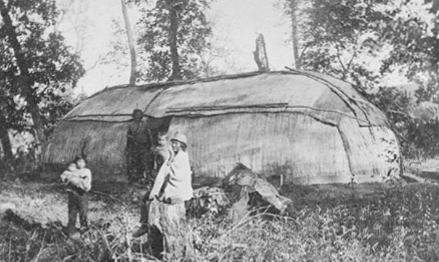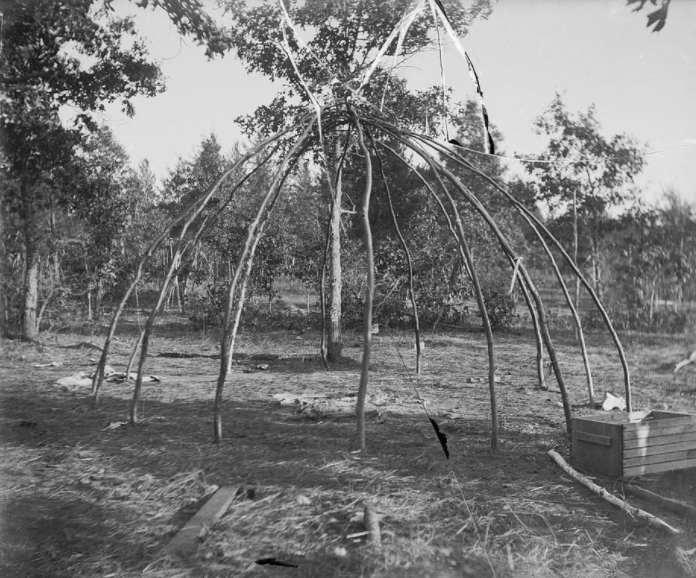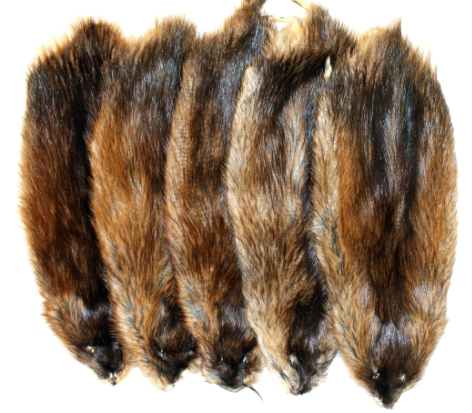
The Four Lakes Indians in 1838
from the report of Ira Hulbert
by Frank E. Smith
(115) Mr. Ira Hulbert, a Wisconsin pioneer, at the present time a resident of Sparta, states that he came to the present location of Madison in October of the year 1838, over the trails from Lake Koshkonong where he and others had been engaged in trapping. He and his companions had made this pilgrimage for the purpose of trading with the Indians then occupying the region about the Four Lakes. Arriving on the shore of Lake Mendota, they visited a large Indian village situated about where Tenney Park is now located.

There were at this time, he estimates, about 500 or 600 Winnebago Indians encamped here and elsewhere about the Madison lakes. He and his companions remained in the locality for only three or four days being greatly discouraged in their efforts at trading with the natives. The Indians wanted calico, tobacco and trade beads but Mr. Hulbert and his companions had brought only a supply of money intending to purchase peltries rather than to trade for them. They were offered thirty muskrat skins for a half-pound of powder. For a handful of glass beads they might have struck a good bargain in furs.
 |
 |
|
| NAA INV 00215900 | BAE GN 4400 | |
| A Mat Covered Lodge | A Bent Pole Lodge Frame |
The Indians were living in wigwams having a framework of bent poles and covered with rush matting and strips of bark. These were scattered about in groups of fifteen or twenty. Their owners were largely engaged in hunting and trapping, the women devoting themselves to weaving rush mats. They appeared, both young and old, to be quite happy and contented. They possessed a few traps and a small number of flintlock guns, the latter being mostly smoothbores and not much to be (116) depended upon for "it was a matter of speculation when the trigger was pulled whether they went off or not." Their bows, ''however, could be relied upon, and when one of these let fly an arrow it usually went about to the spot desired. Their arrows were mostly pointed with flint points, that is, the ones they hunted with. The arrows used around the camp had a blunt head or a sharp wooden point and were nearly all feathered. For a distance of seventy-five yards they made good shots and at from twenty-five to forty yards a wild goose or a duck was almost always their meat, for their aim was quite accurate. Boys of from eight to twelve years of age would knock an old-fashioned penny out of a split stick stuck in the ground at a distance of forty or fifty feet on an average of every other shot. When an adult Indian took his bow and about twenty flint pointed arrows and left camp at daylight he meant business. When he found a flock of geese or ducks feeding near the shore and could get within easy range, say within forty or fifty yards without being seen, he generally bagged several before the flock took flight."
"The lakes had many canoes on almost every shore. Many of these were made of birchbark, and others were hollowed out of logs. These they were very expert in managing." Mr. Hulbert states that "the Indians were great gamblers and were willing to stake from one to twenty muskrat skins on a single game." They played the game of bowl and other gambling games known to the Wisconsin Indians. "They dressed mostly in deerskin, and all had a five-point Mackinaw blanket which they had obtained from the government or elsewhere."
If Mr. Hulbert chanced upon any of the Indian mounds then so numerous about the local lakes he paid little attention to them, nor did he concern himself in questioning the natives concerning their origin or significance. It is interesting that some stone-tipped arrows should have been still in use in this locality. Mr. Hulbert is certain that he is not mistaken on that point.
 |
 |
|
| Etsy | Glacier Wear | |
| A Native American Calico Ribbon-Dress | Muskrat Pelts |
Commentary. "calico" — a plain woven cotton fabric with a small, all-over floral print. Given the quality of the cotton and the weaving, it was inexpensive, and therefore a favorite for the Indian trade. It was extensively worn in the latter half of the XIXᵀᴴ century.
"muskrat skins" — the muskrat trade later became so standardized that a U. S. quarter dollar was called a "muskrat."
"bowl" — basically a game of dice. Six two-sided dice (originally made of bone) are made so that one side is marked and the other not. They are placed in a shallow bowl or dish, and tossed into the air from the dish, then caught back in the dish as they come down. The player gets one point for every die that lands upright.
"Mackinac blanket" — a heavy wool blanket supplied by the United States government for distribution to American Indians. So called because it was originally disbursed from Fort Mackinac [Mackinaw]. The basic design was usually plaid, but they could also be found in solid colors. They were desirable because they were water resistance and easier to sew than hides. Following the French practice, to indicate the size of the blanket while it was still folded, a number of stitched lines were empointer onto the blanket, each line coming to be called a "point." A five-point blanket would have five such strips stitched in it indicating its relatively large size.
Source
Frank E. Smith, "Notes of the Four Lakes Indians," The Wisconsin Archaeologist, 9, #4 (Dec. Feb., 1910): 115-116.